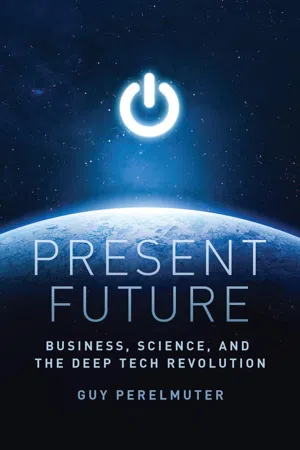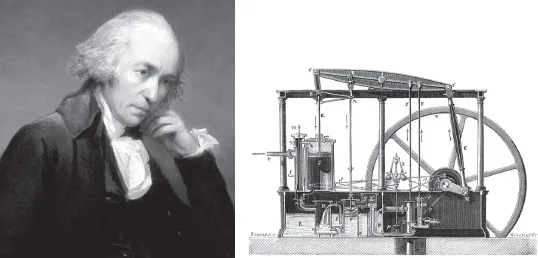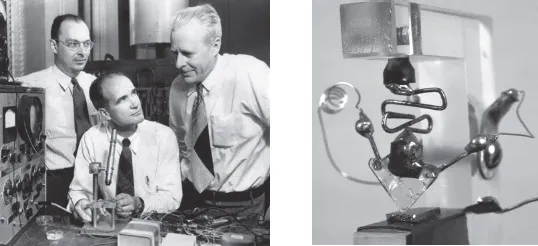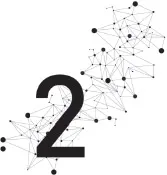![]()
THE WORLD POWERED BY TECHNOLOGY
THE WORLD EXPERIENCED WHAT WE NOW CALL THE FIRST Industrial Revolution beginning around 1760. At that time, the production of goods shifted from individual craftsmen to machines in factories using water and steam power. By 1870, the Second Industrial Revolution (also known as the Technological Revolution) popularized electricity, assembly lines, and the division of labor. Then, once more, beginning in the 1950s, the Third Industrial Revolution—the Digital Revolution—swept the planet, ushering in the era of digital electronics and the so-called Information Age.
(INDUSTRIAL) REVOLUTIONS
These three powerful transitions altered the ways in which different components of production chains interacted with each other, thus impacting not only the economy, but also society, politics, philosophy, culture, and science. These revolutions shaped our world and led to unique questions and challenges for future generations.
English historian Ian Morris in his books Why the West Rules—for Now and The Measure of Civilization: How Social Development Decides the Fate of Nations presents and details a methodology that attempts to quantify the social development that has resulted from specific inventions over the course of history. In other words, how did these inventions impact individuals and society as a whole, affecting their well-being and potential?
Morris concludes that the steam engine produced the most dramatic and fast-paced effect on the progress of civilization. The acceleration of both GDP and population growth are clearly driven by the First Industrial Revolution: Few events have had as significant an impact on humanity as the change from the manual production system to the implementation of automated means of production. This change marked the beginning of a new age of social and economic development with significant changes in the way we access and distribute goods. Even more important, the rate of pollution of Earth was forever changed.
Now, less than half a century after the Third Industrial Revolution, we are seeing a new transformation that will permanently modify how we do business, produce goods, and interact with goods and people: the Fourth Industrial Revolution or what I like to call the Deep Tech Revolution. New technologies are enabling ideas once confined to science fiction to gradually build a more present future: integration between artificial and biological systems, learning techniques for communication between machines and their parts, and the extension of the physical reality into virtual reality (VR). The unprecedented speed and depth of this revolution stems from an auspicious confluence of factors: the increase in computer systems’ processing power, the falling cost of data storage units, the decreased size of equipment and sensors, and the evolution of efficient algorithms.
Figures 1.1 and 1.2. Thomas Newcomen (1664–1729) and his atmospheric engine. Source: Newton Henry Black and Harvey Nathaniel Davis, Practical Physics, New York (Macmillan and Company, 1913)
Figures 1.3 and 1.4. Scotland’s James Watt (1736–1819) used the atmospheric engine invented by England’s Thomas Newcomen, created to remove water from coal mines, as the basis for the development of his own steam-driven engine. Source: National Portrait Gallery NPG 186a, Carl Frederik von Breda
Figure 1.5. The impact of the introduction of the steam engine on humanity. Source: ourworldindata.org based on World Bank & Maddison (2017)
Figures 1.6 and 1.7. John Bardeen (1908–1991), William Shockley (1910–1989), and Walter Brattain (1902–1987) won the 1956 Nobel Prize in Physics for the development of the transistor, which set the stage for the age of portable electronics and microprocessors. Sources: Wikimedia Commons, Getty Images
ALGORITHMS
The crafting of algorithms—sets of instructions which, when executed, solve or complete a given problem or task—was one of the first steps toward the development of automated processes, in which a systematic approach leads to a solution. The word derives from the name of a Persian mathematician, Muhammad al-Khwarizmi (780–850), who was known in Latin as Algoritmi. He created the branch of mathematics known as algebra (in Arabic, al-jabr, which means “reunion of broken parts”), and he was the first to present a methodology for solving systems of equations.
How can—and how should—we prepare ourselves for this new reality? How will advances in nanotechnology, biotechnology, power generation and transmission, artificial intelligence, quantum computing, smart materials (like polymers that change their volume when exposed to an electrical current), telecommunications, robotics, the Internet of Things (IoT), 3D printing, and autonomous vehicles—just to name a few of the technologies that are currently undergoing extensive development—impact us?
“History doesn’t repeat itself, but it often rhymes,” said author Mark Twain (1835–1910), explaining how we can use the past to try to anticipate the future. If we can look to the past to see our future, then we will be witnessing extraordinary changes over the next few decades. From law to engineering, medicine to journalism, design to architecture, entertainment to manufacturing, and economics to education—no field of knowledge will be immune to transformations in processes, models, implementations, methods, and results.
The fact of the matter is that the future has always been present in our lives, because pretty much everything we have and live with today has once been part of someone else’s vision of tomorrow. And even more new jobs, careers, companies, and empires will be created. Others will disappear or evolve into something completely different. The rate at which the world is going to experience these transformations is accelerating rapidly. It is critical that we prepare to face them—in all their forms.
What will these new technologies be? How will they impact our lives, our jobs, and our homes? How are governments, brands, industries, and services going to react? How can we leverage the opportunities that will present themselves and avoid obsolescence? The challenges we will have to face in this rapidly changing world are enormous, and no industry will get through this evolution without significant changes to their processes, products, and their very brands.
OUT OF FOCUS: IGNORING THE FUTURE WHEN IT IS PRESENT
If a picture is worth a thousand words, then a company’s brand is worth ten thousand. Investopedia defines a brand as follows: “The collective impact or lasting impression from all that is seen, heard, or experienced by customers who come into contact with a company and/or its products and services.” A brand can function as a statement of mission, objectives, and values. Although it is a supposedly intangible asset, it is responsible for a huge percentage of the value associated with a company.
At least three groups seek to systematically determine the financial value of the biggest global brands: Interbrand (part of marketing giant Omnicom since 1993); Brand Finance (formed in 1996 by a former officer of Interbrand); and Kantar Group (previously controlled by advertising multinational WPP, who in 2019 announced they would sell a 60% stake to Bain Capital Private Equity).
These companies use different methodologies, but they all focus on large brands—based on criteria such as the number of licensing agreements, revenue, reach, or consumer perception. Their results contain a certain amount of subjectivity, and, consequently, there are some differences among them; nevertheless, they provide a window into the dramatic shifts that can occur. The clearest and most consistent rankings over the recent past point to the prominence of brands connected to technology—which have been around for a relatively short time in business terms: Apple (founded in 1976), Google (1998), Microsoft (1975), and Amazon (1994). When comparing these new entities to other companies such as Coca-Cola (1892), McDonald’s (1940), and Disney (1923), one truth is clear: The speed, both in terms of penetration and of value creation, in the technology sector is incomparable.
Figure 1.8. Sources: ourworldindata.org, Comin and Hobijn (2004), and others
A case in point is the once-valuable global brand Kodak, which was founded in 1888 and filed for bankruptcy in 2012. The advent of digital photography and Kodak’s lack of response to this new technology had devastating consequences for the company. In one of the biggest ironies in the history of business, the first digital camera was actually invented at Kodak in 1975 by Steven Sasson, an engineer who was only 24 at the time. The patent obtained in 1978 earned the company billions of dollars until it expired in 2007, but executives were not willing to sacrifice a business model based on the sale of film, which had been working for decades.
Think about it: This pioneering and unprecedented technology that would have allowed Kodak to maintain its hegemony over professional and amateur photography for years to come had been developed and presented within the company itself, only to later be rejected because it challenged an old business model. In a world where the future is present, this is a hard but important lesson: Adapting to changes from new technology is imperative in the global business setting. And one of the industries whose business model will significantly change over the coming years is the automotive industry, which is over one hundred years old and includes some of the world’s most valuable brands, including Toyota, Mercedes-Benz, and BMW.
![]()
AUTONOMOUS VEHICLES
THE AUTOMOTIVE SECTOR HAS BEEN AROUND FOR MORE THAN a century and is going through a time of transformation that is impacting almost every aspect of it—from the cars themselves, the roads and highways we drive on, and the cost of our insurance policies to regulatory requirements, supply chains, manufacturing processes, and as we will see in the next chapter, consumer behavior.
But let’s back up. The internal combustion engine came on the scene at the end of the eighteenth century. John Barber (1734–1793) obtained the patent for a gas turbine in 1791. Over the following decades, the engine has been refined by different inventors.
OTTO AND LANGEN
German entrepreneur Nikolaus Otto (1832–1891) began his professional career selling sugar and coffee and is a prime example of how the inspiration to innovate and undertake new ventures can be sparked at any time in those who are alert to opportunities in the market. In 1864, he built the first functional atmospheric engine (i.e., without a compressor) with the support of Eugen Langen (1833–1895). Together, they opened the world’s first engine manufacturing plant, NA Otto & Cie. In 1876, Otto patented the four-stroke engine, which is still in use, characterized by its four phases: intake, compression, power, and exhaust.
Fast forward to today, when government regulation and more environmentally conscious consumers continue to drive manufacturers toward alternative technologies (hybrid, electric, and hydrogen vehicles for land, air, and water travel). When considering investments in new energy sources, it is wise to look at current efforts to substantially improve the fuel consumption of traditional internal combustion engines and, consequentially, to reduce emission...







